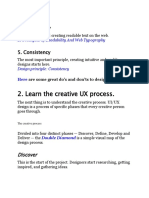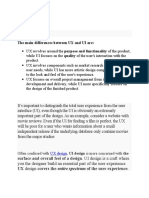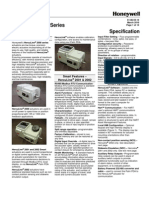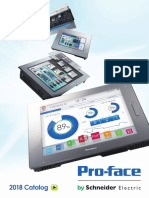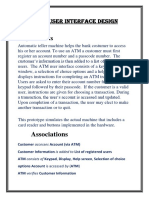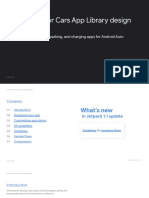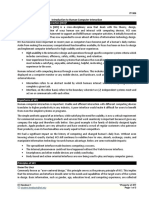UI vs UX: Definitions and Differences
User Interface (UI) refers to the visual and interactive elements of a product. It is the point of human–
machine interaction – for example, screens, buttons, icons, menus, typography, colors, and animations
through which a user operates a website or app 1 2 . UI designers focus on aesthetics, layout, and
responsiveness of each screen or page to make the interface clear and engaging.
User Experience (UX) encompasses the overall feel of a user’s interaction with the product or service. UX
covers all aspects of the end-user’s experience: how easy it is to find information, how intuitive the workflow
is, performance, satisfaction, and even the emotions evoked 3 4 . It is user-centered and research-
driven, considering user needs and behaviors to design products that are efficient and enjoyable to use 4
5 .
In practice, UI is a subset of UX: UI deals with the look and functionality of specific screens or pages, while UX
is the holistic journey a user has with the product. For example, two apps might use identical button styles
(UI) but differ in UX if one is slow and confusing to navigate. Good UX requires good UI, but a beautiful UI
alone does not guarantee a positive UX 2 6 . In short, UI is the surface you see; UX is the overall
experience you feel as you use it.
Key UI Design Principles (Best Practices)
Maintaining strong UI design involves following certain core principles and heuristics. Key UI best practices
include:
• Consistency: Use uniform colors, typography, spacing, and components throughout the interface.
Consistent design makes the UI predictable and learnable 7 8 . As illustrated below, repeating
common card layouts and styles helps users know what to expect on each page.
Figure: Example of consistent UI card layouts. Uniform size, alignment, and style make each card easily
recognizable, with only content changing. This predictability enhances usability.
• Simplicity & Clarity: Keep layouts clean and uncluttered. Prioritize essential elements and remove
unnecessary decoration 9 . Streamline navigation and information so users can focus on their tasks
without distraction. A simple, “lightweight” design reduces cognitive load and helps users
accomplish goals more easily 9 .
• Visual Hierarchy: Organize elements so that the most important content stands out (through size,
color, boldness, or placement). Users should immediately see where to look first. Use headings,
contrast, and spacing to create a clear hierarchy of information.
• Familiar Patterns: Leverage established UI conventions (e.g. menu bars at top or side, buttons
styled consistently, standard icons) so users rely on their prior experience. Familiar layouts and
patterns (found in other apps or OS frameworks) speed up learning. Don’t force users to “reinvent
1
� the wheel” – if a solution already exists for a common problem (like form design or image carousels),
use it 10 .
• Feedback and Visibility: Always show system status and respond to user actions. For example, use
button animations on click, show loading indicators when processing, and display confirmation or
error messages after actions. Jakob Nielsen’s heuristics emphasize “visibility of system status” –
informing users what’s happening reduces confusion 11 .
• Accessibility: Design for all users. Ensure sufficient color contrast, scalable text, and meaningful
labels (for screen readers). Provide alt text for images and tooltips for icons. Use semantic HTML and
ARIA tags so assistive technologies can interpret the UI 12 13 . Accessibility is not just a best
practice, it broadens your user base and is often a legal requirement.
• Affordance and Feedback: Make interactive elements look clickable (e.g. buttons that depress when
clicked). Use visual cues like shadows or hover effects so users recognize what they can interact with.
Provide immediate feedback – for instance, disabling a button while an action processes – so users
know their inputs were received.
Key UX Design Principles (Best Practices)
UX design is driven by understanding user needs and creating a smooth journey. Best practices include:
• User-Centered Research: Begin by listening to users. Conduct user interviews, surveys, and usability
testing to discover real goals and pain points 14 15 . Design decisions should be guided by research
findings, not assumptions. Nielsen Norman Group stresses that quality research is fundamental:
“Nothing is more important for a consistent experience than quality research” 14 . Empathy and user
personas help tailor the experience to real people.
• Usability and Iteration: Design prototypes and test them early and often. Usability testing
(observing real users perform tasks) reveals issues you can fix before launch. Iterate based on
feedback. Strive for high success rates and ease of learning – usability metrics (task success, time on
task, satisfaction) are part of UX. Remember, an interface might look nice (good UI) but still have
poor usability if it is confusing or non-intuitive.
• Holistic Experience: Consider the entire journey, not just individual screens. This includes pre-use
(marketing site, onboarding), core use (main tasks), and post-use (support, feedback). At each step
ensure coherence and delight. UX design also covers non-digital aspects (customer service,
packaging, etc.) that touch the user experience.
• Efficiency: Streamline workflows to minimize steps. An efficient design lets users achieve goals
quickly. As Microsoft’s guidelines note, an efficient UI/UX “reduces friction and streamlines the user
experience, ultimately making it easier for users to accomplish their tasks” 16 . For example,
Amazon’s famous 1-Click checkout eliminated tedious form-filling, dramatically speeding up
purchases 17 .
2
� • Accessibility (UX): Beyond UI accessibility (contrast, etc.), ensure the overall experience is inclusive.
This might mean providing keyboard navigation, captions on videos, or alternative ways to complete
tasks (e.g. voice commands, offline access). Accessibility and UX are deeply related – a site that can’t
be used by someone with a disability is a failed experience for that user.
• Feedback and Guidance: Provide cues and guidance throughout. For example, highlight mandatory
form fields, warn users before destructive actions (“Are you sure you want to delete?”), and celebrate
completion of major tasks (“Thank you for your order!”). Clear feedback reassures users and keeps
them in control. As Microsoft states: “Providing timely and clear feedback assures users that their
actions are being acknowledged and processed by the system” 18 .
UI/UX Design Tools Comparison
UI/UX designers have a rich ecosystem of tools for wireframing, prototyping, and graphic design. Common
tools include Figma, Sketch, Adobe XD, InVision, Axure, Balsamiq, and many others 19 20 . Designers
often also use Adobe Photoshop and Illustrator for detailed graphics or icon work 21 . Below is a
summary comparison of popular tools:
Type/
Tool Key Features
Platform
Cloud-based UI/UX design and prototyping; real-time multi-user
Web-based
Figma collaboration; built-in design system components 22 . FigJam for
(macOS/Win)
whiteboarding.
Vector UI design app with extensive plugin ecosystem; strong
Sketch macOS only integration with prototyping tools (often paired with InVision);
optimized for iOS/macOS interfaces 23 .
Vector UI/UX design and prototyping; supports animations and voice
macOS/
Adobe XD triggers; integrates with Adobe Creative Cloud 24 . (Adobe XD Starter
Windows
plan available.)
Interactive prototyping and design collaboration; supports user
InVision
Web/desktop testing and feedback. (Original InVision is web-based; Studio is
(Studio)
desktop design app.)
macOS/ Advanced wireframing and prototyping; supports complex
Axure RP
Windows interactions, conditional logic, and documentation for specs.
Rapid low-fidelity wireframing; sketch-style UI elements to mock up
Balsamiq Web/desktop
screens quickly.
Simple design, prototyping and testing; integrates with handoff
Marvel Web
tools.
Design and prototyping with built-in code components; supports
UXPin Web
design systems and real data.
3
� Type/
Tool Key Features
Platform
Developer handoff – generates style guides, specs and assets from
Zeplin Web/desktop
designs (works with Figma, Sketch, XD).
Code-based responsive prototyping (uses React under the hood);
Framer macOS/Web
supports animation and advanced interactions.
Miro (or Collaborative whiteboard for brainstorming, flowcharts, journey
Web (Browser)
FigJam) mapping and remote workshops (FigJam is Figma’s board).
User testing and analytics platform; integrates with Figma/Sketch to
Maze Web
test prototypes.
Design teams often use a combination of these tools depending on needs. As one guide notes, Figma and
Sketch are among the most popular UI/UX tools 20 . The table above is a snapshot; the field evolves with
new tools (see, e.g., AI-assisted design tools emerging in 2025).
Real-World Case Studies
• Figure: Example of Airbnb’s redesigned app interface (2025). The app now combines home rentals, local
experiences, and in-home services into a unified booking flow. Airbnb App Overhaul (2025): In May
2025 Airbnb launched a completely redesigned mobile app that lets users book homes, local
experiences, and new services (like chef-catered meals or photography sessions) all from one place
25 . By integrating these categories into a single, coherent interface, Airbnb streamlined the user
journey – a clear UX strategy to keep travelers within one platform. This example shows how
rethinking the UI around customer needs (e.g. bundling services with stays) can enhance the overall
user experience 25 .
• Amazon One-Click Checkout: A classic UX example is Amazon’s patented 1-Click ordering (patent
expired in 2017). This feature lets customers buy items with a single click by storing their payment
and shipping info. When introduced in 1999 it “was unheard of” and became a breakthrough in
reducing purchase friction 17 . By minimizing the checkout steps, Amazon significantly increased
conversion rates and user satisfaction. This case underscores how simplifying tasks (core UX) can
provide a major competitive advantage 17 .
• (Additional Example) Many tech products illustrate good UI/UX in action. For instance, Slack’s clean
sidebar navigation and immediate message feedback foster easy communication (UI consistency
and instant feedback). Similarly, Spotify’s personalized homepage and “Discover Weekly” playlists (UX
personalization) keep users engaged. While space limits detailed study, the key lesson is that
successful products align UI design with real user needs and streamline their experience.
4
�Learning UI/UX Design (Resources, Courses,
Careers)
For aspiring UI/UX designers, the field is approachable via many paths. Key guidance includes:
• Educational Resources: Start with foundational books and online tutorials. Classic books are “Don’t
Make Me Think” (Steve Krug) for usability and “The Design of Everyday Things” (Don Norman) for
human-centered design. Online blogs and courses are plentiful: Nielsen Norman Group’s articles,
Smashing Magazine, UX Collective (Medium), and A List Apart offer practical insights. Many
platforms offer structured courses or certificates, e.g. Google’s UX Design Professional Certificate on
Coursera, Interaction Design Foundation courses, or bootcamps like General Assembly or
CareerFoundry. These cover user research, wireframing (often in Figma or Sketch), prototyping, and
portfolio development. Government resources (e.g. Digital.gov’s human-centered design guides 26 )
can also be useful for fundamentals.
• Practice and Tools: Build hands-on skills by designing real or mock projects. Practice with common
tools (e.g. Figma, Sketch, Adobe XD) to create wireframes, mockups, and prototypes. Many tools
have free tiers for learners. Participate in design challenges (like daily UI) or redesign exercises to
apply principles. Conduct small usability tests with friends or colleagues to get feedback and iterate.
Keep an online portfolio showcasing your projects and process.
• UX Community and Feedback: Join UX communities (e.g. UX StackExchange, Reddit r/
userexperience, Slack/Discord groups) to ask questions and share work. Attend meetups, webinars,
or workshops (virtual or local) to learn from practitioners. Mentorship and peer critique are
invaluable for growth.
• Career Path: UI/UX roles often start at entry-level as a Junior UX/UI Designer. With experience (~2–3
years) one moves to Mid-level (UX/UI Designer); senior designers or Product Designers typically require
~5+ years and often lead projects. Specialized roles include UX Researcher, Interaction Designer, or
Visual (UI) Designer. Leadership roles (Design Lead/Manager/Director) involve overseeing strategy
and teams. According to industry data, UI/UX designers are well-compensated: in the US the
median salary for a UX designer is around $83K, and for a UI designer around $94K 27 , with Senior
UX Designers making ~$125K 28 or more. Demand is high – the Bureau of Labor Statistics projects
about 8% growth for UX-related jobs through 2033 29 , faster than average.
Career
Typical Titles Skills/Focus
Stage
Entry / Junior UX Designer, UI Basics of wireframing/prototyping; familiar with design
Junior Designer tools; understanding user research concepts.
UX/UI Designer, Visual Conduct user tests; create high-fidelity prototypes; solid
Mid-Level
Designer grasp of UX research and visual design principles.
Senior UX Designer, Lead design projects; strategy and information
Senior
Product Designer architecture; mentor juniors; data-driven iteration.
5
� Career
Typical Titles Skills/Focus
Stage
UX Researcher, Interaction Focus on research, interaction details, or content/UX
Specialist
Designer, UX Writer copywriting; often work closely with designers.
UX Manager, Design Oversee design teams and projects; align UX strategy
Leadership
Director with business goals; communication with stakeholders.
• Continual Learning: UI/UX is an evolving field. Stay current with new tools (e.g. AI-assisted design),
platforms (mobile/AR/VR), and trends (design systems, accessibility standards). Build a habit of
reading case studies and post-mortems from companies. Consider formal certifications (e.g. Nielsen
Norman UX Certificate) if helpful. Finally, network: connect with other designers on LinkedIn and
share your work. With a strong portfolio, user-centered mindset, and willingness to learn, many
paths can lead to a fulfilling UI/UX career.
Sources: Definitions and guidance are drawn from UX design experts and industry research 1 4 14 8
16 17 27 , among others. All points above are based on current best practices and case studies in the UI/
UX design field.
1 What Is a User Interface (UI)? | Definition from TechTarget
https://www.techtarget.com/searchapparchitecture/definition/user-interface-UI
2 UI vs UX: What's the Difference between UI & UX Design? | Figma
https://www.figma.com/resource-library/difference-between-ui-and-ux/
3 User experience - Wikipedia
https://en.wikipedia.org/wiki/User_experience
4 The Definition of User Experience (UX) - NN/G
https://www.nngroup.com/articles/definition-user-experience/
5 6 What Is User Experience (and What Is It Not)? - NN/G
https://www.nngroup.com/articles/what-is-user-experience/
7 10 14 Design Consistency Guide with 9 Best Practices
https://www.uxpin.com/studio/blog/guide-design-consistency-best-practices-ui-ux-designers/
8 9 12 15 16 18 Key UI/UX design principles - Dynamics 365 | Microsoft Learn
https://learn.microsoft.com/en-us/dynamics365/guidance/develop/ui-ux-design-principles
11 13 10 Usability Heuristics for User Interface Design - NN/G
https://www.nngroup.com/articles/ten-usability-heuristics/
17 Why Amazon’s '1-Click' Ordering Was a Game Changer - Knowledge at Wharton
https://knowledge.wharton.upenn.edu/podcast/knowledge-at-wharton-podcast/amazons-1-click-goes-off-patent/
19 Prototyping Tools For Designers
https://www.meegle.com/en_us/topics/prototyping/prototyping-tools-for-designers
20 21 22 23 Graphic Design Classes NYC & Online
https://www.nobledesktop.com/topics/graphic-design-courses
6
�24 The 10 Best UI Design Tools to Try in 2025
https://www.uxdesigninstitute.com/blog/user-interface-ui-design-tools/
25 2025 Summer Release: Now you can Airbnb more than an Airbnb
https://news.airbnb.com/airbnb-2025-summer-release/
26 Usability – Digital.gov
https://digital.gov/topics/usability
27 28 29 How Much Can I Make as a UX Designer? 2025 Salary Guide | Coursera
https://www.coursera.org/articles/ux-designer-salary-guide
